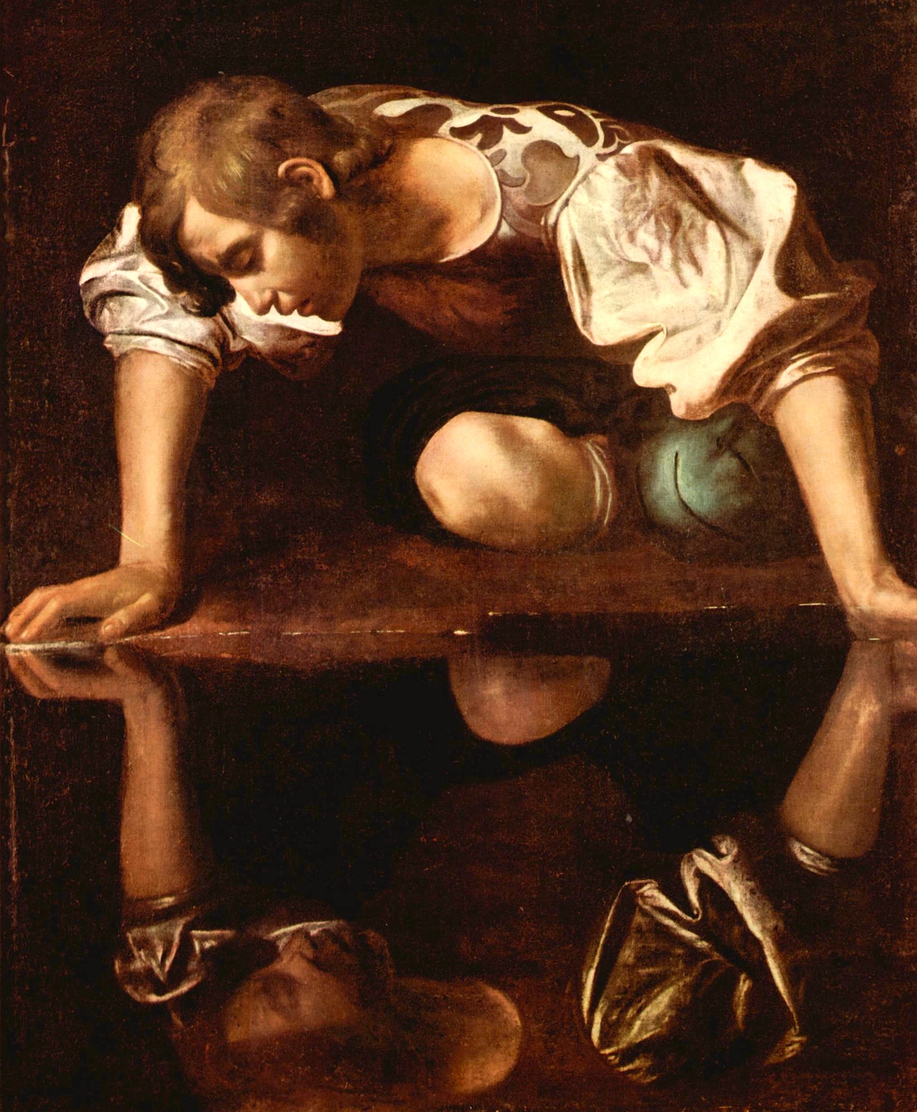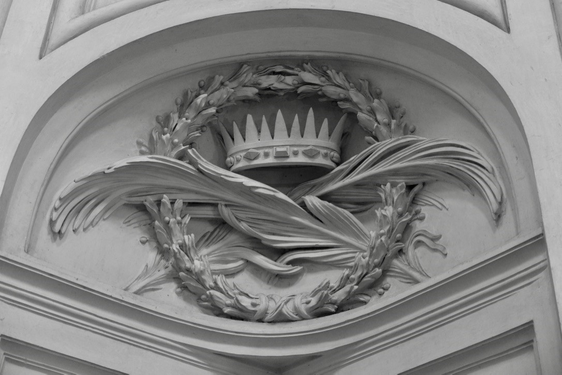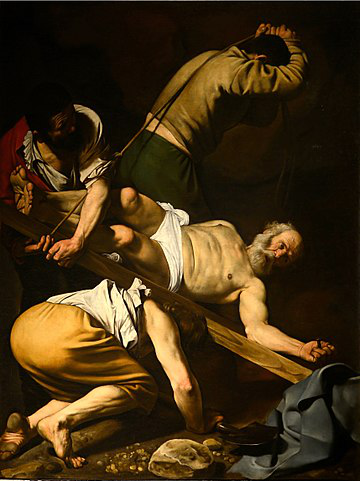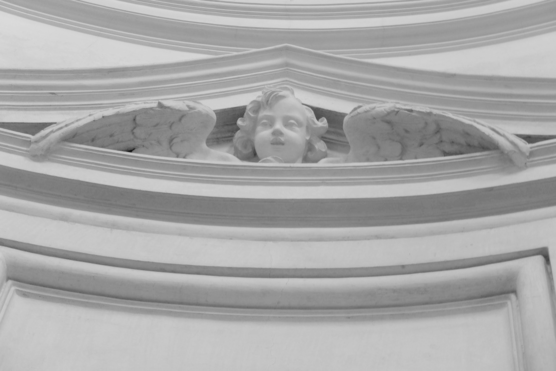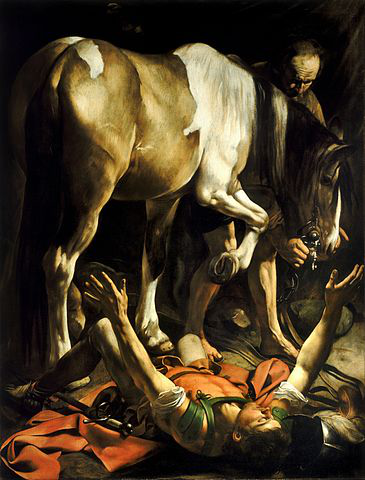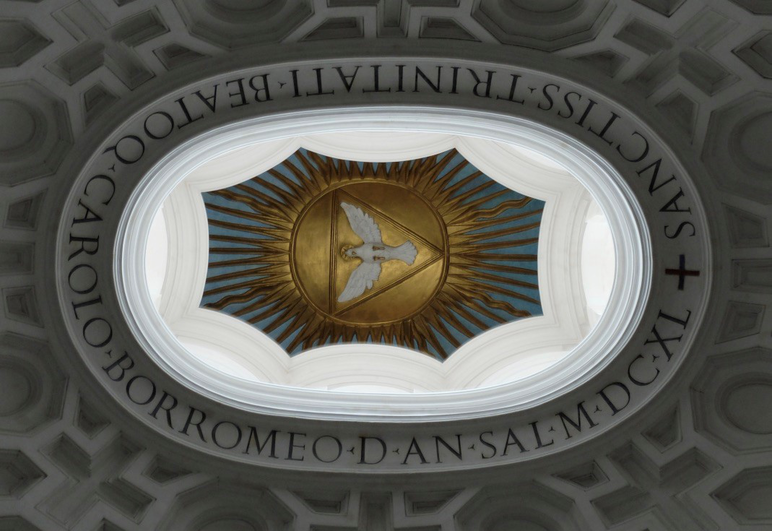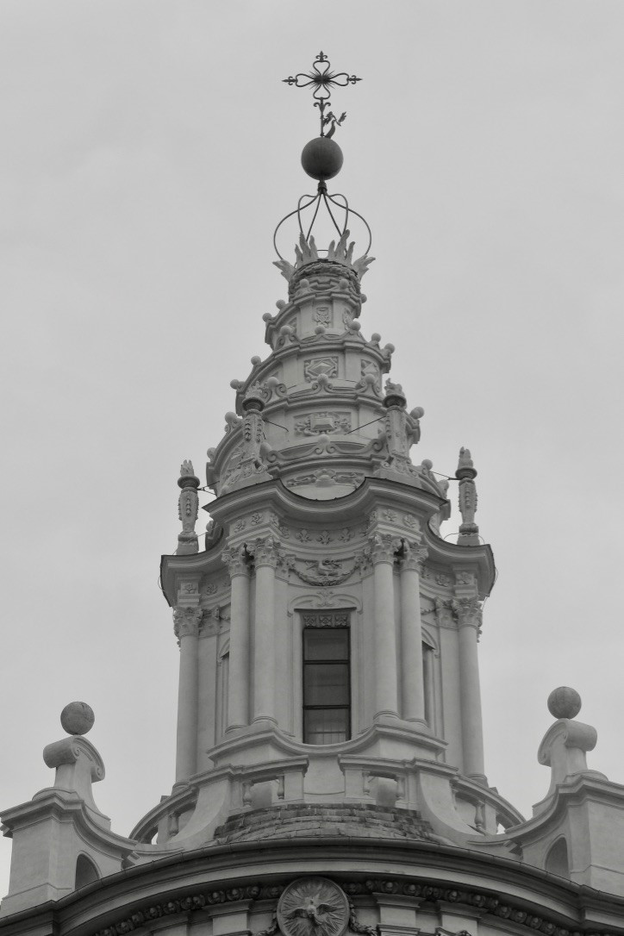[...]The art of chiaroscuro is a skill of the master architect too. In great architectural spaces, there is a constant deep breathing of shadow and light, shadow inhales and illumination exhales light.
The white diffused light that comes from the lateral hidden windows and from the windows of the lantern in the middle, in which the symbol of the Trinitarian order appears to have no support as well, transforms the whole interior in a plastic and vibrant unity, with no sense of having been constructed out of separate elements. This is mentioned by Portoghesi, as “the absolute unity of the surfaces that constitutes the space, emphasized by the transfiguring force of the luminous fluid”.
This ”guided” light, according to the same author, is not only an element of unification of the space but gives also variation and contrast due to the tonal game between light and dark surfaces.
Architecture is the masterly, correct and magnificent play of masses brought together in light.
Testified by this famous statement from Le Corbusier, one of the most important architects of twentieth- century modernism, light is indeed the most fascinating element of Borromini’s work, part of a personal and highly symbolic language comparable to Caravaggio’s own representations of the sacred themes. One of the most wonderful achievement of the interior of the church, is indeed the use of the light and the way Borromini starts from a geometric and rational impulse at the ground plan level, making this symbolic geometry alive and present in both structure and decoration, in a sensorial gesture that reverberates and unifies throughout the whole interior.
However, in the opposite wall of the chapel, the Conversione di San Paolo (The conversion of Saint Paul) couldn’t be a more contrasting representation. The centrifuge forces that define the composition of the previous painting, are now replaced by a convergent representation centered in the open arms of the apostle, all physical action replaced by profound stillness and suspended time of the spiritual moment of St Paul’s conversion, - the Roman official Saul, persecuting Christians on his way to Damascus, is blinded by a light, falls down from his horse and hears the voice of Christ. Caravaggio isolates the scene in profound darkness concentrating the look on the relation between the man in a trance and the horse with a raised foreleg (the only visible movement), held by an old servant. The fact that the horse occupies most of the painting, enhances the vulnerability of Saul’s body. The unstable inverted pyramid formed by the outstretched arms, increases the tension of the scene, all attention now focused on the emotional and physical response of the future apostle, blinded by a descending light from the upper right corner of the painting.
Part 3. Dome, Illusion and the exploration of the surface
Poetry is called a speaking Picture, Painting a mute Poem. To one is appropriate a dumb loquacity, to the other an eloquent silence[.… ]Nor is there any difference between them except that one imitates with colour, the other with words; one imitates principally the externals, the lineaments of the body, whereas the other imitates internal things, that is, the emotions of the soul.
O come sei gentile
The theme of the duality present in this painting, as in most of Caravaggio’s work (tradition- innovation, sacred- realism, realism-illusion, chiaro-scuro), can also be related to the further development of the duet form in Monteverdi’s Seventh Book, Concerto, from 1619.
The predominance in the Seventh Book of the duet form for two equal voices (Narciso and his reflection), with eight duets for two tenors, five for two sopranos (or nine if we consider the four parts of the duet Romanesca), and one for two altos, is a strong indication of Monteverdi’s interpretation of the classic humanist themes of nature and imitation, based in the realistic nature of the human emotions; the via natturale alla imitatione.
In the duet for two sopranos O come sei gentile, set on a poem from Guarini, the two voices, freed by the harmonic support and continuity that the relative new technique of the basso continuo allows, start in strict imitation alternating with homo-rhythmically contrasting sections, in a succession of quick shifts and motions responding in almost pictorial way to the illustration of the words.
In the short transitional declamatory section, Ma in questo, the character of the piece changes to a darker tone introducing the ambiguity of the final words. In the final verse, vivi cantando et io cantando moro, as a result of the intertwined structure and the continuous overlapping of the two voices, Narciso and his reflection are not anymore distinguishable from each other and become one, much in the same way that Caravaggio’s circle could represent life and death with the thin line that divides one from the other.
The inventor of painting, according to the (ancient) poets, was Narcisus[…]The tale of Narcisus fits our purpose perfectly. What is painting but the act of embracing by means of art the surface of the pool?
This inhibition of the dominant sense of vision, in order to create a more intimate emotional response, is described by Juhani Pallasmaa in his book The eye of the skin:
During overpowering emotional experiences, we tend to close off the distancing sense of vision […] Deep shadows and darkness are essential, because they dim the sharpness of vision, make depth and distance ambiguous, and invite unconscious peripheral vision and tactile fantasy.
Opening Saul’s body to the intimate experience of darkness through an intense blinding light, Caravaggio enhances his vulnerability isolated him from the outside. Palasmaa goes on describing what he calls acoustic intimacy:
In emotional states, sense stimuli seem to shift from the more refined senses towards the more archaic, from vision down to hearing, touch and smell, and from light to shadow.[…] The sense of sight implies exteriority, but sound creates an experience of interiority[…] The eye reaches but ear receives.
In this sense, the musical construction of the instrumental choirs in Con che suavita, could be related to the monumental sculptural figures of the Cappella Cerasi, in the creation of an independent and free representation that aims to be real, exterior and almost theatrical but also intimate and sensorial, as the experience of a kiss or the revelation of a religious moment.
The Dome
The conflict present in Guarini’s poem, finds its final compromise between kiss and word, expressed by Monteverdi through the confluence of the voice and the three instrumental choirs in the last part of Con che suavità.
Similar to Caravaggio’s painting, where the dialectic presence of light and darkness coexist in the light that blinds Saul in the moment of his conversion, in the last level of Borromini’s church, the Dome, all complexity of the interior described in the previous parts of this research, seems to resolve in silence and wonder.
The most essential experience created by architecture is tranquility. Architecture presents the drama of construction silenced into matter, space and light. Ultimately architecture is the art of petrified silence.[…]
A powerful architectural experience silences all external noise; it focuses our attention on our very existence, and as with all art, it makes us aware of our fundamental solitude.
Marino
With Concerto, what seems to be a steady and methodical progression in Monteverdi’s innovation into the madrigal form, enters into a new phase of experimentation in the relation between text and music, with an increasing role of the instruments as elements of textural contrast and expression.
Among the reasons for this apparent shift, one relevant influence appears to be Marino’s poetry in Monteverdi’s choice for his music settings. His first contact with this poet, as referred to by Denis Stephens, occurs with the setting of five poems from Marino’s first published book, La Lira (1602), set to music during the composer's last years in Mantua and later published. Although this was commissioned by the Duke of Mantua, the fact that Monteverdi decided to include these pieces in his Sixth Book is significant of the musical possibilities he saw in, and the inspiration he got from Marino’s poetry.
It is also in Mantua, during the wedding festivities in 1608, that Marino sees Guarino’s play Il Pastor Fido, and the first performance of Monteverdi’s Arianna. In his work Adone, published in Paris in 1622, he recalls the moment of the lament of Arianna.
And in such guise, o Mantua, you heard Florinda,
There in the theatres beneath your royal roofs,
Declaim the bitter sufferings of Adrianna
And draw from a thousand hearts a thousand sights.
If in Marino’s words we can read how deep his admiration was for Monteverdi’s work and for the reach of his expressive musical approach, this appreciation seems to have been mutual, as the Seventh Book opens with the setting of Marino’s Tempro la Cetra, establishing the tone for the whole book, in the same way that Guarini’s poems from Il Pastor Fido opened Monteverdi's Fifth Book of Madrigals. With Tempro la Cetra, we are now fully in the world of the marvelous (meraviglia) and the direct expression of the senses, which became Marino’s distinctive poetic language, and seemed to be one of the main inspirations to this new phase of experimentation in the composer's work.
Inspired in Aristoteles Poetics and Rhetoric, artists and poets of the Renaissance looked for the fantastic and marvelous as a necessary plot ingredient of tragic drama, produced by an unexpected turn of events or surprising effects. James Mirollo describes the notion of the marvelous as follows:
The marvelous, the unexpected and the extraordinary response aroused in a reader by a concetto, (idea, concept) a poem, a painting, a statue, etc […]. This response is aroused by virtuosity, technical feats, causing the impression of beauty and insight. Emphasis on formal virtues, the artist has to find and express the marvelous hidden in nature or undo nature by making something new.
In this way, the expansion of the original poetic material, through imitation, repetition, metaphors and the use of objects from the real world, opens up a new field of poetic possibilities and innovation, making Marino’s poetry essentially visual, tactile and musical.
Comparable to Marino’s poetical language, with the extended use of metaphoric images, also in Borromini the incorporation of decorative elements charged with symbolic meaning, becomes part or make more visible the structural elements and constitute one of the main aspects that gives his architecture an unique and personal character.
The helicoidal tower on top of the lantern in Sant’Ivo alla Sapienza, is an example of the combination of two different interpretations: functional, through a sooth walk to the top making it accessible from the exterior, and symbolic, with the decorative elements disposed as jewels in a crown following the upward movement of the spiral. These symbolic and metaphorically charged elements, that can be related to Wisdom and Charity, are part of a sculptural gesture which seem to result from the interaction between inner and outer space, following the vertical tension of the interior through the continuity of the spiral form. The same gesture used by Borromini in the lateral stairs of the Barberini palace, in its aspiration to the infinite.
Con che suavità
In Monteverdi’s search into a madrigal form that could be simultaneously “constructed” and free, much in the same way Borromini’s own experimentations in San Carlino and Sant'Ivo alla Sapienza were, Con che suavità, the madrigal for solo voice with instrumental accompaniment, included in Monteverdi’s Seventh Book, can be seen as an example of the experimentation and exploration of sonorities through the instrumental setting, illustrating the duality and conflict inherent in Guarini’s text.
In order to express in music the duality between word and kiss or intellect and senses, Monteverdi divides the instrumental setting into three choirs according to the tone colour of the instruments; the first and third choir are mainly continuo groups, while the second with the violins, more flexible, reinforces the voice sharing its melodic material.
Introducing in this way a variety of texture and contrasting colours, supported by an ambiguous tonal structure, declamatory parts alternate with monody and canzonetta like melody in a succession of contrasting moments. In this context, the relation with Marino’s world of the senses and the marvelous, can be seen in the surprisingly amount and unusual combination of instruments to accompany a work for solo voice, in its impulse towards a structure in music composition of contrast, expansion and surprise.
The incorporation of the instruments replacing the voices in Con che soavitá, suggests that Monteverdi moves from a language that he totally controls, the madrigal, almost to the dissolution of that same language. In this process, word and by extension the text become pictorial elements, the instruments now freed to create a sensorial landscape and a new spatial dimension to the music.
Crocifissione di San Pietro e Conversione di San Paolo
If Monteverdi’s Seventh Book presents a new phase of thematic and compositional freedom, partly inspired by Marino’s poetry and its world of the exploration of the surface and the senses, Caravaggio’s shift at the beginning of the century seems to go in the same direction in his original representation of sacred themes and the simultaneous exploration of the limits of the pictorial surface.
From the first naturalistic and lyric phase of his youth (from which Narciso is one of his last and most expressive examples), Caravaggio moves to a more realistic representation of the sacred themes, combined in a highly symbolic narrative, which in some cases appears to be staged in order to produce a direct sensorial and emotional response on the viewer.
Caravaggio’s lateral paintings of the Cerasi Chapel in Santa Maria del Populo in Rome, are two examples of this important painter’s stylistic shift, which like most of his important commissions, encountered both resistance from the Roman church and admiration from his contemporaries.
In these two representations of sacred themes, the figures gained a greater sculptural force and are barely contained within the frame. However, the concentrated narrative is achieved with less but effective means which simultaneously tend to expand the figures beyond the picture surface, connecting with the space of the viewer placed in an oblique angle in the Chapel.
Borromini’s continued and almost obsessive search for dolcezza or suavità, (softness) in architecture, is expressed in his own words when justifying the curved façade of the Oratorio di S.Filippo in Rome as “ inspired by the human body, with open arms as one does when embraces everyone who enters”.
This gesture, repeated in the façade of Sant' Ivo alla Sapienza, could be seen as a reminder of Saul’s open arms accepting the divine words in the form of light in Caravaggio's painting, or Monteverdi’s attempt to embrace word and kiss, voice and instruments in Che con suavità. Here, the abstract instrumentation works as an independent support that interact with the vocal line, similar to the way in which Borromini's church of San Carlino, the surface of the Dome seems to inhale all the complexity of the interior and quietly exhale light and silence.
next page
On the left wall of the Chapel, in Crocifissione di San Pietro, the apostle is crucified head down (as he declared himself unworthy to die in the same way as Christ), Caravaggio’s attention concentrated on his physical and spiritual trial. The four figures, seem to occupy the same space and importance within the frame, in equal geometric lines and forces that define the composition of the painting. These figures, which pull in all four directions in contrary movements, introduce elements of great diagonal tension that the light simultaneously controls and emphasizes.
Narciso
Caravaggio’s Narciso from 1597, can be seen as a powerful illustration of the relation between painting and poetry described in the words of the poet Gianbattista Marino. It is in Galeria from 1619, a collection of madrigals and sonnets divided into Pitture e Sculture, that the poet expresses his admiration for the visual arts and the artists. One of the poems is based on Caravaggio’s version of this classical myth from Ovid’s Methamorphoses: The beautiful Narciso is attracted to a pool where he falls in love with his own reflection in the water, leading to his death. Caravaggio treated this theme by erasing all landscape and objects in a dark background, to focus entirely on the figure of the boy admiring himself, where shadow and light seems to be combined to create a staged dramatic scene. The circle that is formed by Narciso and its reflection (where his knee seems to occupy the center of the composition), is divided by the waterline in two almost equal parts, in this way expressing both the lyricism of Ovid’s myth and the symbolic elements contained in its narrative.
|
O come sei gentile, Caro Augelino O quanto el mio stato amoroso al tuo simile io prigion tu prigion io canto tu canti per colei che t'ha legato Et io canto per lei. Ma in questo è differente la mia sorte dolente Che giova pur a te l'esser canoro vivi cantando et io cantando moro.
|
How gracious you are, dear little bird, and how my state as lover is similar to yours: I am prisoner, you are prisoner; I sing, you sing for her who captured you, and I too sing for her. But in this my doleful fate differs from yours: to be a songbird helps you in your plight; singing you live, but singing I die |
In my personal experience of the church, it is indeed an overwhelming sense of intense silence and extraordinary harmony that one feels in its interior.
As Paolo Portughesi also describes: “In San Carlino, all complexity is transformed in silence, in a simplicity of form absolutely transcendent.”
With shifting the base of the pure elliptical dome behind the cornice on top of the supporting arches, and placing the only windows of the church in this posterior plan not visible from the floor, Borromini creates his last illusion, that of a fluctuating dome.
In its surface, an intricately and exquisite pattern of carved stucco figures, octagons, hexagons and crosses, all related to the Trinitarian symbolism, creates a three-dimensional effect due to the contrast of light and shadow, enhanced by the fact that the size of the shapes diminishes as they get closer to the center, creating an effect of optical expansion, which makes the dome seem taller and deeper. Although these symbolic forms were used before, it is absolutely original the way they interact, as a living organism or an expanding Universe, in a display of the architect technical skills and poetic interpretation of the space.
|
Con che suavitá, labra odorate, E vi bacio e v’ascolto! Ma se godo un piacer, l’altro m’`e tolto. Come i vostri diletti Sáncidono fra lor, se dolcemente Vive per ambedue l’anima mia? Che soave armonia Fareste, ocari baci, o dolci detti, Se foste unitamente Dámbedue le dolcezza ambo capaci: Baciandi i detti I ragionando I baci. |
With what sweetness, adored lips, I both enjoy kiss and listen to you! But if I enjoy one pleasure, the other is denied me. Why do your delights kill one other, if my soul lives sweetly for both? What delicate harmony You could create, o dear kisses, o sweet words, Were you capable of both sweetness at once: Kissing words and discoursing kisses. |
